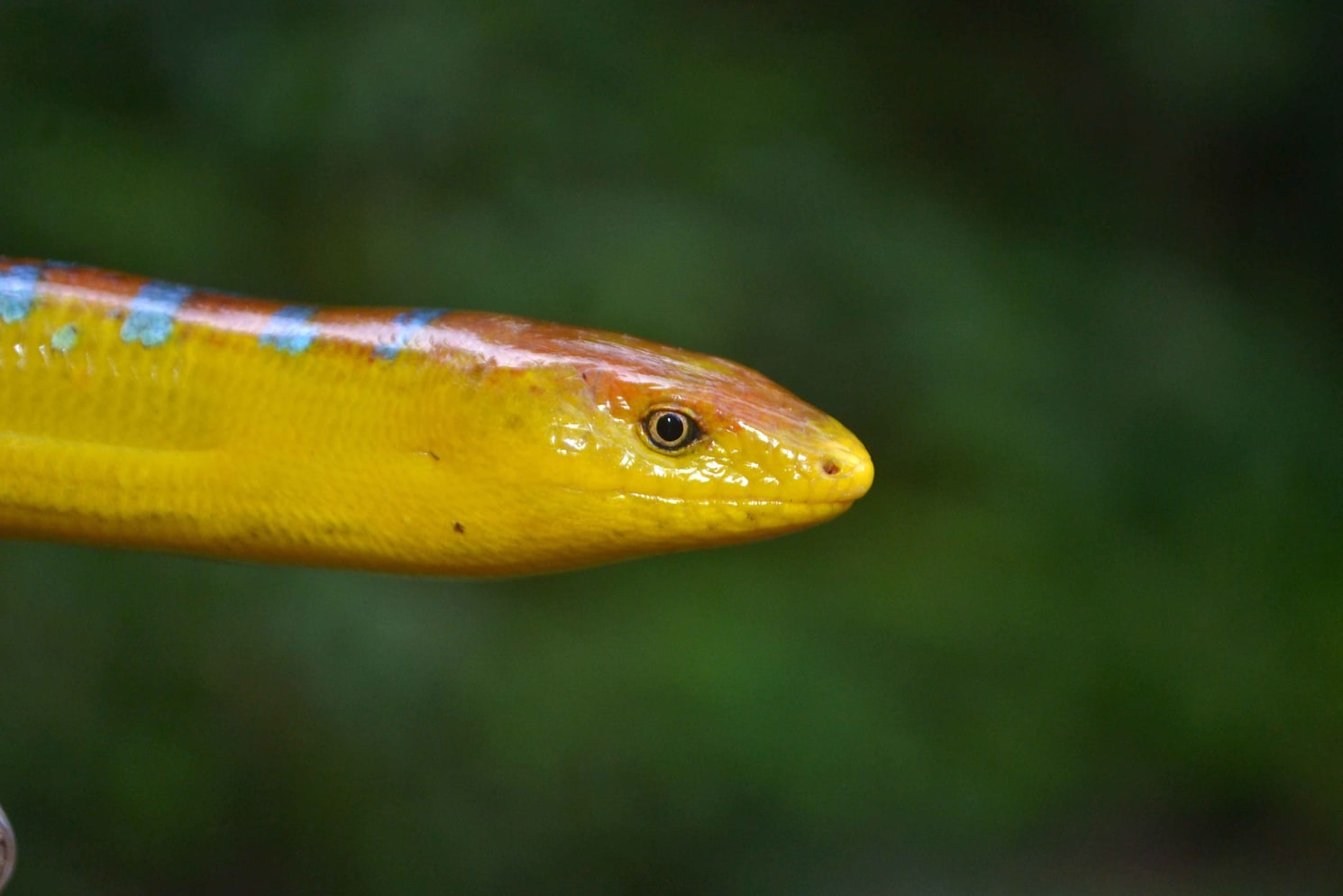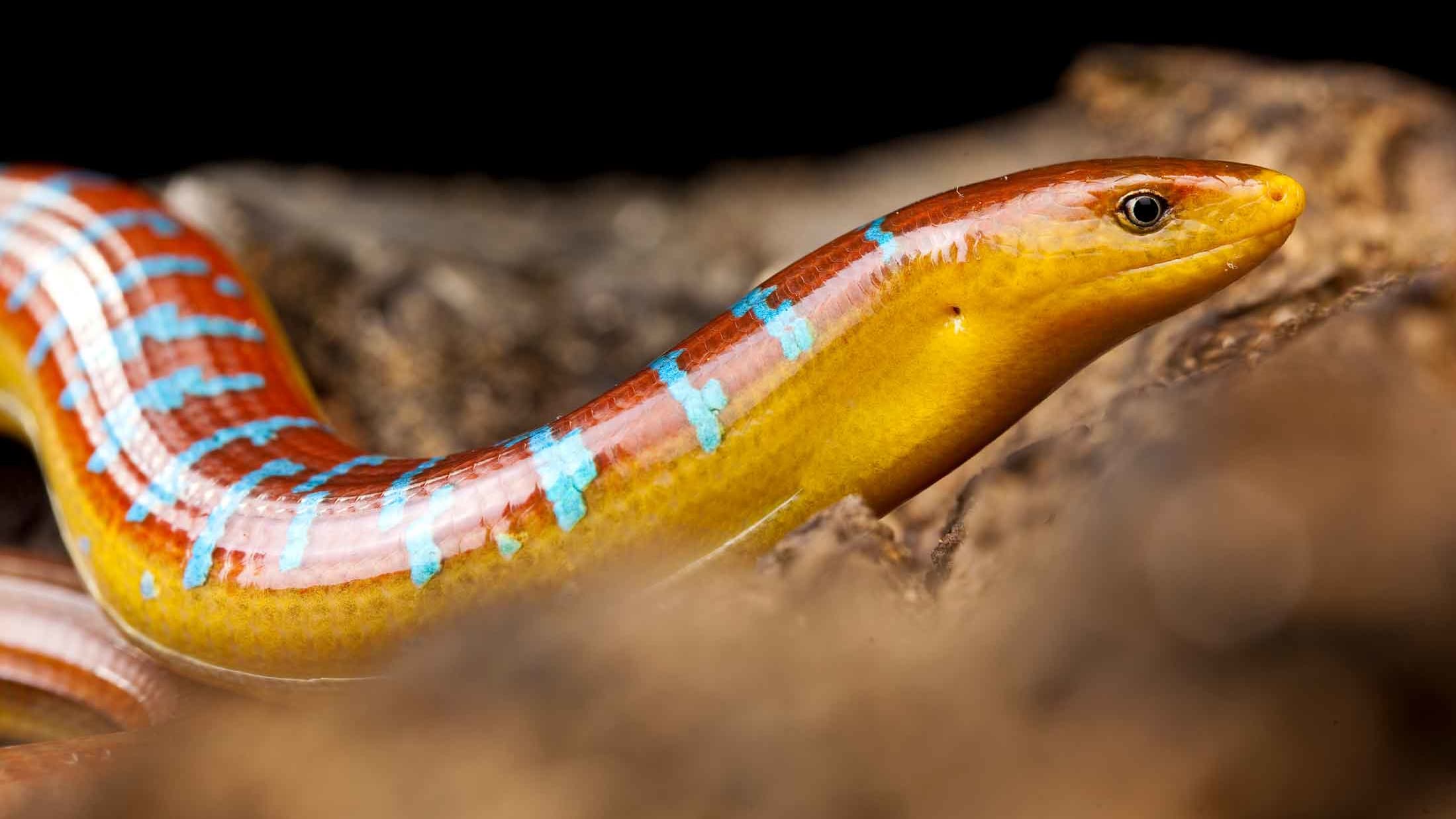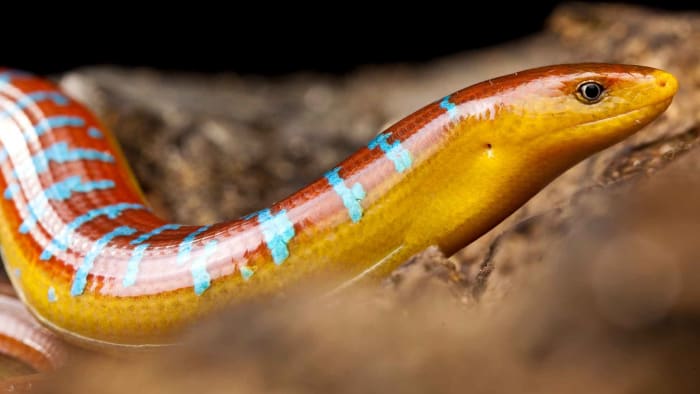 Listen to this article
•
15:34 min
Listen to this article
•
15:34 min
Some of my most amazing and vivid memories of the natural world come from Arunachal Pradesh’s forests. Amongst the best of these occurred in 2012 when we were about 2,000 m high on the ridge of a mountain within the most idyllic forest landscape. Picture sphagnum moss draped and hanging from almost every branch. Surfaces were wet from clouds passing through the forest, occasionally shrouding everything. Then the sun breaks through in a contest with the clouds. It lights up a forest floor covered in leaf litter and punctuated by a thick mat of bright green moss covering fallen logs and the edges of rocks. Then, an animal that is an absolute anomaly in form and colour appears, bejewelling this already dream-worthy scene. A legless lizard that is garnet coloured with electric blue bands across its back — the Asian glass lizard (Dopasia gracilis) might be the most exquisite reptile I’ve ever seen.
Bright bands as protection
Growing to a total length of about 45 cm, most of this lizard is its tail, the body making up less than a third of the length. It has a rather dull tail compared with the dazzling blue-striped body. This unique and spectacular colour pattern is one way this otherwise defenceless animal can avoid predation. Like numerous other lizards, the glass lizard can sacrifice its tail to save its life from predators. The bright bands confuse the attacker into misjudging the speed of its movement and shifting focus to the visually less stunning tail. The predator is more likely to then attack the tail, which the lizard discards at an opportune moment in a process called caudal autotomy. Here, a lizard’s tail breaks along “fracture planes” or weak points, allowing it to escape with its life while the predator focuses on the captured piece of tail.

In their youth
On a trip to Arunachal Pradesh, we found a young glass lizard that looked nothing like the adults. It was a sandy cream-coloured animal with black streaks down the length of its back. Some glass lizards are known to change ontogenically (from their neonate to adult stages). Changes in colour and even dentition are reported from other species of anguids. Looking at various pictures of the species and seeing them in such a variety of shades and patterns, it is likely that the Asian glass lizard also changes through life. This could possibly be due to a difference in its microhabitat niche and/or prey preference. Unfortunately, we know next to nothing about our glass lizard despite how unique and incredible it is.
Legless wonders
Asian glass lizards are part of a family of lizards called Anguidae. Though it may seem like not having limbs is the decisive factor putting them into this group, that’s not the case. The main features that make up anguids include skull structure, dentition, a fold in the skin on their sides, and osteoderms (bony deposits within the scales or skin). The osteoderms give them a little added protection from smaller predators, ranging from ants and other predatory invertebrates to small birds.
The glass lizard is part of a genus (Dopasia) that consists of seven species known from South and Southeast Asia. However, there are legless anguids found in Europe, North America, and Africa as well.

Mistaken for a snake
The Nyishi tribe folk we were with in Arunachal Pradesh believed the glass lizard that we found was a deadly venomous snake. Unfortunately, the bright colours and serpentine movement don’t protect legless lizards from ignorance and myth. It took a lot of explanation about how to distinguish it from a snake to convince them. Amongst many other differences, lizards have an exterior (and usually visible) ear opening, movable eyelids, and very different scales from snakes.
Additionally, seeing how docile and gentle the animal was, helped us convince our friends that this was not an animal to be feared and killed on sight. Whether they’d consequently not kill the next one they saw is anybody’s guess. But, at the very least, there would be no “reason” in their minds to do so.
Although harmless to humans, the glass lizard is an effective predator, feeding on insects, small lizards, amphibians, and small rodents. It can move quite fast while chasing prey and seems to depend a lot on sight. It stands to reason that these legless lizards will have adapted mechanisms similar to snakes. They are likely very adept at chasing and capturing legged prey, even down burrows, or other tight spaces.
Living underground
Most of the glass lizards I’ve seen were spotted while rooting through leaf litter or looking under logs. The animal is known to be fossorial, i.e., lives underground. Which is perhaps why it isn’t seen much and is consequently listed as “rare”. In areas where jhum or shifting cultivation is practiced in Arunachal Pradesh, local folks see them often; especially while clearing new patches of land.
Arunachal Pradesh has been a space where one might find the most incredible species right in the middle of towns and sometimes cities. We’ve found glass lizards in tiny slivers of forested spaces in the heart of busy towns.
However, with the advent of massive infrastructural ventures like roads and large hydroelectric projects, the future of these anguids and so many other species from biodiverse regions is bleak. India’s Northeast is a place of wonder, the possibility of bumping into jewels like the glass lizard is always high. Without radical changes in policy and our approach to development, we will lose such species without ever learning a tiny fraction about their lives and natural histories. Knowledge aside, the fact is that a world without the glass lizard will be a truly diminished place.








